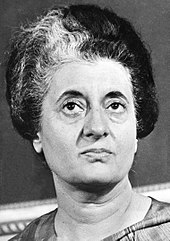
Back حالة الطوارئ (الهند) Arabic ভাৰতৰ জৰুৰীকালীন অৱস্থা, ১৯৭৫ Assamese इमरजेंसी (भारत) Bihari ভারতে জরুরি অবস্থা (১৯৭৫-১৯৭৭) Bengali/Bangla Ausnahmezustand in Indien 1975–1977 German État d'urgence (Inde) French કટોકટી કાળ (ભારત) Gujarati מצב החירום בהודו HE आपातकाल (भारत) Hindi Masa Darurat (India) ID
This article needs additional citations for verification. (January 2025) |

The Emergency in India was a 21-month period from 1975 to 1977 when Prime Minister Indira Gandhi declared a state of emergency across the country by citing internal and external threats to the country.[1]
Officially issued by President Fakhruddin Ali Ahmed under Article 352 of the Constitution because of a prevailing "Internal Disturbance", the Emergency was in effect from 25 June 1975 and ended on 21 March 1977. The order bestowed upon the prime minister the authority to rule by decree, allowing elections to be cancelled and civil liberties to be suspended. For much of the Emergency, most of Gandhi's political opponents were imprisoned and the press was censored. More than 100,000 political opponents, journalists and dissenters were imprisoned by the Gandhi regime.[1] During this time, a mass campaign for vasectomy was spearheaded by her son Sanjay Gandhi.
The final decision to impose an emergency was proposed by Indira Gandhi, agreed upon by the President of India, and ratified by the Cabinet and the Parliament from July to August 1975. It was based on the rationale that there were imminent internal and external threats to the Indian state.[2][3]
- ^ a b Bose, Sugata; Jalal, Ayesha (2024), "The Indian Emergency (1975–1977) in Historical Perspective", When Democracy Breaks, Oxford University Press, pp. 221–236, doi:10.1093/oso/9780197760789.003.0008, ISBN 978-0-19-776078-9
- ^ "Interview with Indira Gandhi". Interview relecast through India times. TV Eye. 18 December 2016. Retrieved 14 June 2018.
- ^ "Recalling the Emergency years". The Indian Express. 29 June 2015. Retrieved 14 June 2018.